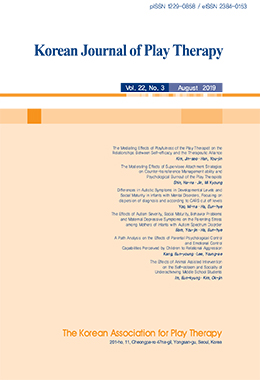본 연구에서는 정신장애 영유아의 CARS 절단점에 따른 세 집단 간 진단분포, 발달수준, 사회성숙도 및 자폐증상의 차이를 검증하였다. 연구 대상은 종합병원 소아정신과 2곳과 재활의학센터 1곳 등에서 정신장애로 진단된 만 1세부터 만 5세 영유아 307명이었다. 본 연구의 결과는 다음과 같다. 첫째, 집단 간 발달수준 및 사회성숙도의 차이를 검증한 결과, K-BSID-Ⅱ의 MDI는 ASD 집단의 점수가 자폐증상 없음 집단의 점수보다 유의하게 높았으며, SMS의 SQ는 ASD 성향 집단, 자폐증상 없음 집단 점수가 ASD 집단의 점수에 비해 유의하게 높았다. 둘째, 집단 간 CARS 척도의 차이를 검증한 결과, 사회적 의사소통, 반복적 상동적 행동, 특이한 감각반응 등 3개의 하위 요인에서 ASD 집단, ASD 성향 집단, 자폐증상 없음 집단 순으로 점수가 높았으며, 집단 간 차이가 유의하였다. 또한 사람과 관계, 모방, 신체 사용, 물체 사용, 변화에 대한 적응, 두려움과 신경과민, 언어적 의사소통, 비언어적 의사소통, 활동수준, 지적 반응 수준과 항상성, 일반적 인상 의 문항은 ASD 집단, ASD 성향 집단, 자폐증상 없음 집단 순으로 점수가 높았으며, 집단 간 차이가 유의하였다. 넷째, 집단 간 CBCL 1.5-5의 DSM 진단 척도 차이를 검증한 결과, DSM 정서문제, DSM ADHD, DSM 반항행동문제의 T점수는 ASD 집단의 점수가 자폐증상 없음 집단의 점수보다 유의하게 높았으며, DSM 전반적 발달문제 T점수는 ASD 집단, ASD 성향 집단, 자폐증상 없음 집단 순으로 점수가 높았고, 집단 간 차이가 유의하였다. 이와 같이 본 연구에서는 CARS 절단점에 따른 세 집단 간 발달수준 및 사회성숙도, 자폐증상의 차이를 검증하여, CARS 척도에서 절단점을 넘지는 않았으나 자폐 성향을 보이는 영유아의 임상적 특성을 분석하였다는 데 의의가 있다.
The purpose of this study was to verify the differences of autistic symptoms in dispersion of diagnosis, developmental levels, and social maturity in three groups of infants with mental disorders according to CARS cut off levels. The results of this study were as follows. First, the results of the differences by developmental levels and social maturities in the three groups studied were as follows. The MDI in K-BSID-Ⅱ on the non-autistic symptoms were significantly higher than the ASD group. SQ(social quotient) in SMS on the ASD tendency group and the non-autistic symptoms group were significantly higher than those of the ASD group. Secondly, the results of the differences of the three sub-factors in CARS in the three groups were as follows. The three sub-factors, namely, social communication, repetitive-stereotyped behaviors and unusual sensational responses in CARS were significant according to the groups. The ASD group had the highest score, with the next being the ASD tendency group, and then followed lastly by the non-autistic symptoms group. Thirdly, the results of the differences in scores from the questionnaire survey in CARS were as follows. The ASD group had the highest score, followed by the ASD tendency group, and then followed lastly by the non-autistic symptoms group. The scores were found to be significant between groups. Lastly, it was observed that the ASD group had the highest score, the ASD tendency group coming next, and then lastly followed by the non-autistic symptoms group in the T score of the DSM pervasive developmental problems in CBCL 1.5-5. As can be seen, the scores were found to be significant between groups.




